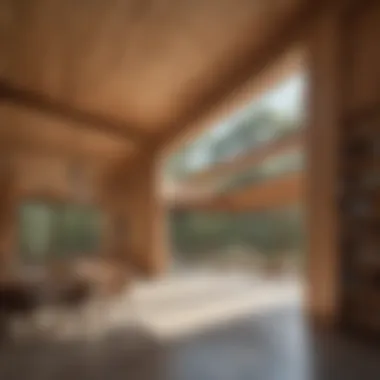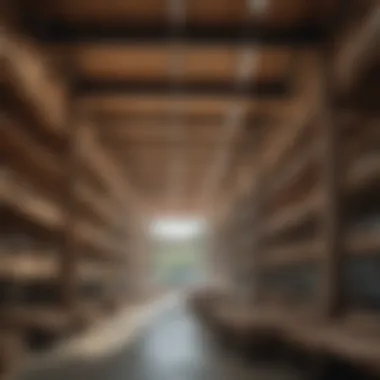Cross Laminated Timber: Sustainable Innovation in Construction


Intro
In recent years, cross laminated timber (CLT) has gained significant attention as a sustainable construction material. This interest coincides with a broader understanding of the need for sustainable innovations in the architectural landscape. CLT factories serve as pivotal players in this evolution. They not only produce a cutting-edge building material but also embody principles of sustainability that resonate with contemporary ecological challenges. Understanding the context in which these factories operate is crucial for appreciating their impact on both the construction industry and our environment.
Understanding Woodland Ecosystems
Importance of Biodiversity in Forests
Forests are complex ecosystems that support a wide variety of life. They are home to countless species of plants, animals, and microorganisms. The biodiversity found within these ecosystems is essential for maintaining ecological balance. Each species plays a role in the food web and contributes to the forest's overall health. When forests are sustainably managed, the preservation of biodiversity can thrive.
Role of Forests in Climate Regulation
Forests act as carbon sinks, absorbing carbon dioxide from the atmosphere through photosynthesis. This process not only mitigates climate change but also regulates local climates. Healthy forests provide shade and cooling effects, influencing weather patterns in surrounding areas. Furthermore, sustainable forestry practices support this regulation by ensuring that forest resources are used responsibly, allowing ecosystems to recover and thrive.
Sustainable Forestry Practices
Principles of Sustainable Forestry
Sustainable forestry focuses on maintaining the health of forest ecosystems while meeting present and future needs. The key principles include:
- Maintaining Forest Health: Ensuring that forests can regenerate and thrive.
- Responsible Harvesting: Minimizing waste and impacts on the environment.
- Community Engagement: Involving local communities in decision-making processes.
- Protecting Wildlife Habitats: Safeguarding the ecosystems that support diverse species.
Case Studies of Successful Implementations
Several regions around the world have successfully implemented sustainable forestry practices. For instance, the Forest Stewardship Council (FSC) certification is a model that promotes responsible forest management. Organizations achieving this certification demonstrate compliance with ecological standards, which helps consumers make informed choices. These case studies highlight the potential for sustainable practices to enrich both economic viability and ecological integrity.
Woodland Stewardship Techniques
Forest Management Plans
A forest management plan outlines the strategies for maintaining and improving forest health. These plans typically include objectives, management practices, and timelines. They are essential for ensuring compliance with sustainable forestry guidelines. Key components often involve monitoring forest conditions, assessing biodiversity, and planning for regeneration.
Conservation Strategies
Conservation strategies are crucial for protecting biodiversity and ecosystem services in forests. These can include:
- Protected Areas: Setting aside parts of forest land to preserve wildlife and habitats.
- Restoration Projects: Efforts to restore degraded lands back to a healthy state.
- Community Programs: Involving local populations in conservation efforts and educating them on sustainable practices.
The synergy between technological advancements in manufacturing processes and sustainable forestry practices creates a pathway for achieving ecological harmony.
This relationship is critical to the future of cross laminated timber and its role in environmentally conscious building practices.
Intro to Cross Laminated Timber
Cross Laminated Timber (CLT) stands as a leading innovation in the push towards sustainable building materials. In a time when environmental impact is under increasing scrutiny, the significance of CLT cannot be overstated. This section gauges the essence of CLT, its functionalities, and the merits it brings to the construction and architectural landscape.
Sustainability and resource efficiency are at the core of contemporary building practices. CLT offers unique advantages, including reduced carbon footprints and increased energy efficiency. The composition of CLT allows for effective use of wood as a renewable resource, which is critical given the growing concern over deforestation and resource depletion. By utilizing timber in a cross-laminated format, manufacturers enhance the strength and stability of the material while also improving sustainability outcomes.
In addition to environmental benefits, the physical properties of CLT present numerous considerations for architects and builders. High strength-to-weight ratios, excellent thermal insulation properties, and design versatility affirm its role in modern architecture. The ability to span larger distances without needing excessive support is especially appealing for various building types. These features position CLT not only as a practical choice but also as a transformative option in construction.
As we deepen our understanding of Cross Laminated Timber, it is crucial to explore its definition and historical development, setting the stage for a comprehensive look at its qualities and applications.


Manufacturing Process of Cross Laminated Timber
The manufacturing process of cross laminated timber (CLT) is crucial in the context of sustainable innovation within the timber industry. This is not just about producing a building material; it involves engaging with ecological systems, ensuring quality, and meeting market demands. Understanding the intricacies of this process helps in appreciating the environmental advantages that CLT offers.
Raw Materials and Sourcing
CLT is primarily made from softwood species, although hardwoods can also be utilized. Common types of wood include Spruce, Pine, and Fir due to their availability and structural properties. The sourcing of these raw materials is pivotal. Responsible forestry practices ensure that the timber is harvested sustainably, promoting reforestation and biodiversity. This approach mitigates the risk of deforestation and maintains ecological balance. Timber from certified sources, such as the Forest Stewardship Council (FSC), guarantees that the wood is sourced in an environmentally friendly manner. Additionally, collaborating with local timber suppliers supports regional economies, reducing transportation emissions and costs.
Production Techniques
The production of CLT involves several well-defined steps. The process begins with drying the wood to a specified moisture content, which is essential to prevent deformation in the final product. Once dried, the timber is cut into lamellae, which are individual boards that will be layered. These lamellae are then glued together in layers at a right angle to one another, typically three to five layers thick. This crosswise configuration enhances the strength and stability of the material.
The gluing process is vital. Adhesives used must comply with strict environmental regulations, providing durability without compromising health standards. After the layers are assembled and glued, they are pressed under specific conditions to ensure a strong bond. The panels are then trimmed to the correct dimensions and undergo further finishing processes if required, such as sanding or coating. The end result is a highly durable and versatile construction material ready for use in a variety of applications.
Quality Control Measures
Maintaining high-quality standards during production is essential for the performance and safety of CLT. Comprehensive quality control measures are in place at various stages of manufacturing. Inspections begin with the raw materials, assessing their moisture content, structural integrity, and sourcing certifications. During production, various tests are performed, including adhesive bond tests and structural tests to evaluate the strength of the panels.
Moreover, advanced technology is increasingly being integrated into quality assurance processes. Automated systems can monitor production environments and test samples in real-time, ensuring that every batch meets the required specifications. Regular audits and adherence to local and international standards are carried out to maintain compliance and improve production methods continuously.
The emphasis on rigorous quality control ensures that CLT maintains its reputation as a reliable and sustainable building material, suitable for a variety of structural applications.
Overall, the manufacturing process of cross laminated timber encapsulates a commitment to sustainability. From sourcing to production, each stage is designed not only to create a high-quality product but also to enhance the ecological landscape in which we build.
Benefits of Cross Laminated Timber
Cross Laminated Timber (CLT) presents myriad benefits that underscore its significance in modern construction practices. In an age where sustainability is at the forefront of architectural discourse, CLT offers a compelling pathway to meet environmental, economic, and aesthetic demands. Its versatility and inherent properties make it more than just a building material; it is a solution to pressing ecological concerns and design challenges. The benefits of CLT are not limited solely to its physical attributes. They also embody a broader commitment to sustainability and responsible resource management.
Sustainability and Environmental Impact
One of the most profound aspects of Cross Laminated Timber is its contribution to sustainability. CLT is derived from renewable timber resources, which means its production can be aligned with sustainable forestry practices. When sourced correctly, these materials can greatly reduce carbon footprints. Trees absorb CO2 during their growth, and when they are processed into CLT, the carbon remains stored within the material. Thus, utilizing this kind of timber effectively acts as a carbon sink, combating climate change.
Moreover, CLT manufacturing involves the efficient use of raw materials. Unlike conventional timber structures, CLT panels utilize smaller trees and less desirable wood species, helping to preserve old-growth forests. This practice ensures a more sustainable approach to timber extraction, improving the overall health of forest ecosystems.
Another environmental consideration is the energy consumed during the manufacturing process of CLT. Factories typically utilize advanced technologies that minimize waste and energy use, thereby reducing the environmental impact of production. This level of efficiency stands in stark contrast to traditional building methods, which often face criticisms for their high levels of resource consumption and waste generation.
"The choice of building materials can have a significant impact on a project's environmental footprint, and CLT consistently proves to be a favorable option."
Thermal Efficiency and Insulation Properties
Cross Laminated Timber is renowned for its remarkable thermal efficiency. It possesses natural insulating properties that contribute to energy savings in buildings. The interlocking layers of timber in CLT panels create air pockets that act as insulation, reducing heat loss during colder months and minimizing heat gain during warmer months. This results in lower energy consumption for heating and cooling, which is essential for sustainable building design.
In practical terms, buildings constructed with CLT can maintain more stable indoor temperatures, translating into practical comfort for occupants. The benefits extend beyond individual buildings; widespread adoption of CLT can lead to a reduction in energy demand across urban environments. Additionally, minimizing energy requirements eases the dependency on fossil fuels, further advancing sustainability goals.
Structural Strength and Design Flexibility
The structural capabilities of Cross Laminated Timber are another compelling benefit. CLT panels exhibit exceptional strength and stiffness, which allows architects and engineers to design innovative structures that were previously thought impractical using traditional materials. This strength enables taller timber structures, challenging the misconception that timber is inferior to materials like concrete and steel.
Moreover, the flexibility in design provided by CLT can accommodate a variety of architectural styles, making it suitable for diverse applications. From residential homes to commercial buildings, CLT allows for open spaces and large spans, giving architects freedom to explore avant-garde designs without compromising structural integrity.
The ability to prefabricate CLT panels further increases design possibilities. Pre-manufactured panels reduce construction timelines, increase quality control during production, and minimize on-site disruptions.


In summary, the benefits of Cross Laminated Timber touch various aspects of sustainability, efficiency, and design flexibility, making it a critical component in the evolution of modern construction practices.
Challenges Faced by CLT Factories
The emergence of cross laminated timber (CLT) factories marks a significant advancement in sustainable construction. However, like any industry, these factories face several challenges that can impact their growth and efficiency within the market. Addressing these issues is crucial, not only for the success of CLT manufacturers but also for the broader adoption of sustainable building practices. In this section, we will explore three key challenges: supply chain constraints, regulatory standards, and market competition.
Supply Chain Constraints
Supply chain management is a vital aspect of the CLT manufacturing process. Sourcing quality timber sustainably is often difficult. Forest depletion and stricter environmental regulations can limit access to raw materials. Additionally, transportation logistics can create delays that impact production timelines. Factors such as fuel prices and transportation capacity can also raise costs. This tight situation can lead to production bottlenecks, affecting overall output and profitability. Efficiently managing these constraints is essential for manufacturers to ensure a consistent supply of materials and maintain profitability.
Regulatory Standards and Compliance
Compliance with regulatory standards is another major challenge for CLT factories. Building codes related to timber construction are evolving. Each region may have different regulations, complicating the production and distribution processes of CLT products. Factories must stay abreast of changing laws to avoid penalties and ensure that their products meet safety standards. This not only requires ongoing training and education for factory staff but also necessitates robust quality assurance practices. Non-compliance can discredit a manufacturer and undermine the general credibility of CLT as a sustainable solution.
Market Competition and Pricing Structures
As the demand for sustainable building materials grows, competition among CLT producers intensifies. This can lead to price wars, often reducing profit margins for manufacturers. Additionally, competitors might introduce alternative materials that can threaten the market position of CLT. Factories must adopt innovative business strategies to differentiate their products. Understanding the pricing structures in relation to production costs is essential for sustainability. The need to communicate effectively about the benefits of CLT is vital in a crowded marketplace.
"The challenges in CLT manufacturing are significant, but addressing them can lead to stronger and more resilient factories."
Cross Laminated Timber in Architecture
Cross Laminated Timber (CLT) represents a pivotal shift in modern architectural practices. Its unique attributes make it an appealing choice for architects seeking sustainable building materials. CLT is not just a product; it embodies a philosophy of eco-friendliness and efficiency that resonates well within contemporary design ethos.
The integration of CLT in architecture serves several distinct benefits. Firstly, it allows for a reduced carbon footprint compared to conventional materials like steel and concrete. Timber is a renewable resource, and, when sourced responsibly, it can significantly mitigate adverse environmental effects. Secondly, CLT offers design versatility, enabling innovative structures that would be challenging to achieve with other building materials. Its strength and lightweight nature facilitate large spans and open floor plans, allowing for greater creativity in design.
The fire resistance and thermal performance of CLT are also crucial considerations. CLT structures are constructed with layers oriented at right angles to one another, enhancing their overall stability. This multi-layer configuration provides a certain level of natural insulation, reducing energy consumption in heating and cooling, which is essential in sustainable architecture. Moreover, architects often favor the aesthetic charm of exposed timber, creating warm and inviting spaces. However, while the benefits are evident, careful planning is necessary to overcome some of the limitations associated with CLT in architectural applications.
Innovative Architectural Applications
CLT has opened up new frontiers in architectural design. Many architects are exploring its use in various applications, including residential buildings, commercial spaces, and public structures. One standout example is the University of Tasmania's Design Studio, a pioneering project that showcases the aesthetic and functional capabilities of CLT.
Another significant application is the construction of mid-rise buildings, which traditionally relied on reinforced concrete. CLT enables lighter and faster construction, reducing labor costs and project timelines. Notable examples include the Brock Commons Tallwood House in Canada, which stands as one of the tallest wooden buildings in the world.
The integration of CLT in modular construction is also gaining traction. Prefabrication increases manufacturing efficiency and quality control, minimizing on-site construction waste. Architects can create complex forms and structures that were previously challenging or cost-prohibitive with conventional methods. This innovation is particularly beneficial for urban areas where construction space and time are limited.
Building Codes and CLT Compliance
As with any building material, compliance with local building codes and regulations is essential when utilizing CLT in architecture. Currently, building codes vary significantly across different regions, which can pose challenges for architects. Many areas have stringent fire safety regulations that may affect the use of timber products, including CLT. Nonetheless, advancements have been made in testing and standards development, leading to wider acceptance of CLT in structural applications.
Designers often need to demonstrate that CLT structures meet or exceed local fire protection requirements. For instance, demonstrating fire resistance can be accomplished through rigorous testing and the implementation of fire retardant treatments. Engineers must also account for structural calculations to ensure the materials used can withstand local environmental conditions.
In summary, successful incorporation of CLT into architectural design involves understanding both its potential and challenges. The journey of CLT from raw material to architectural component showcases a commitment to sustainable and innovative practices that can redefine the future of construction.
The Role of CLT in Sustainable Development
Cross Laminated Timber (CLT) plays a pivotal role in the ongoing discourse around sustainable development. As our built environment increasingly seeks to mitigate the effects of climate change, CLT emerges as a versatile solution that aligns with the principles of ecological preservation and resource efficiency. The intersection of construction and environmental stewardship is critical in understanding how CLT can contribute to sustainable development in both urban and rural contexts.
Integration with Renewable Energy Sources
One of the prominent aspects of CLT's role in sustainable development is its compatibility with renewable energy sources. Factories that produce CLT can effectively integrate solar panels and wind turbines into their operations, minimizing their carbon footprint. Utilizing renewable energy not only decreases operational costs but also enhances the sustainability of the entire manufacturing process.


Additionally, CLT structures themselves can be designed to harness renewable energy. For instance, buildings made from CLT can incorporate solar panels directly onto the timber framework, optimizing energy generation while maintaining aesthetic appeal. This synergy between CLT and renewable energy illustrates a forward-thinking approach to construction and resource management.
"The future of construction lies not merely in building but in building responsibly, where every component harmonizes with our ecological goals."
Community and Economic Impact
The impact of CLT extends beyond environmental considerations; it resonates significantly with community and economic factors. Investing in CLT factories can bolster local economies by creating jobs in manufacturing, construction, and even forestry sectors. Employment in these fields tends to lead to the development of a skilled workforce, fostering economic resilience.
Moreover, CLT promotes sustainable land-use practices. By utilizing timber derived from responsibly managed forests, CLT production supports local forestry economies while ensuring the preservation of natural landscapes. This relationship can enhance community ties to their natural resources, encouraging a culture of conservation and stewardship.
Furthermore, as demand for sustainable materials grows, CLT often becomes a preferred choice among architects and builders. This can stimulate local markets and create new business opportunities in related sectors, such as sustainable design and eco-friendly construction.
In summary, the role of Cross Laminated Timber in sustainable development encapsulates both environmental and socio-economic considerations. By harnessing renewable energy and promoting local economic growth, CLT not only addresses the pressing challenges of climate change but also enriches communities and supports their evolution toward sustainability.
Future Trends in Cross Laminated Timber Production
The potential of Cross Laminated Timber (CLT) factories is intertwined with the ongoing trends in technology, sustainability, and market demand. A deep exploration of these future trends reveals significant shifts in how timber is utilized not only for construction but also for promoting an eco-conscious building industry. Continued advancements in production processes and design innovations are poised to redefine the landscape of sustainable construction.
Technological Innovations on the Horizon
Recent developments in technology are transforming the fabrication of CLT. Innovations in software, such as Building Information Modeling (BIM), allow architects and designers to visualize and plan constructions with greater precision.
Additionally, automated production techniques are on the rise. These methods can streamline manufacturing, improve material efficiency, and reduce waste. Emerging technologies such as robotic arms for cutting and placement can enhance accuracy and reduce labor costs.
Another critical area is materials science. Research into hybrid materials, which combine CLT with other sustainable materials, offers new opportunities for enhanced structural performance. For example, combining CLT with recycled plastics may yield products with better resistance to weather and pests. This innovation addresses various durability concerns while also capitalizing on recycled materials.
Furthermore, as smart buildings become more prevalent, integrating sensors and smart technology into CLT products is a vital future direction. Smart buildings can optimize energy use and improve occupancy comfort, thus further emphasizing CLT’s role in sustainability.
"The future of CLT production lies in marrying advanced technology with traditional craftsmanship; this synergy will create unprecedented opportunities for sustainable design."
Market Expansion and New Opportunities
The global demand for sustainable building materials is increasing. This presents CLT factories with numerous opportunities for market expansion. With more governments enforcing stricter environmental regulations for construction, the preference for eco-friendly materials is likely to grow.
New markets, particularly in regions previously reliant on conventional materials, are increasingly open to adopting CLT due to its sustainable profile. As timber becomes recognized as a viable alternative to concrete and steel, the scope for CLT manufacturing and distribution expands significantly. Moreover, educational institutions are incorporating CLT in curriculums, fostering a new generation of architects and builders experienced in sustainable practices.
The construction sector is also seeing a shift towards modular building systems, where pre-manufactured components are assembled on-site. CLT fits perfectly within this framework as it is lightweight and easy to transport.
In summary, the combination of technology advancements and market readiness is setting the stage for remarkable growth in CLT production. The combination of increasing awareness of sustainability and technological progress indicates a future where CLT becomes a predominant material in modern architecture.
The End
The conclusion of this article emphasizes the increasing significance of Cross Laminated Timber (CLT) factories in our contemporary world. As we navigate the complexities of environmental sustainability and innovative architectural design, the role of CLT cannot be overstated. These factories exemplify how timber can be utilized not only for its structural capabilities but also as a vehicle for eco-friendly practices.
Summarizing the Importance of CLT Factories
CLT factories represent a revolutionary shift in material production. They amalgamate sustainability with modern construction needs. One key aspect of their importance is the reduction of carbon footprint. By utilizing wood sourced from sustainably managed forests, CLT production inherently promotes environmental stewardship. Furthermore, these factories facilitate a circular economy approach by maximizing timber usage and minimizing waste.
Moreover, CLT’s versatility allows architects and builders to explore new designs while adhering to stringent building codes. This is critical in contexts where adaptability and resilience are paramount. The ability to construct large structures with reduced materials engages with the trends of minimalism and efficiency prevalent in today’s architecture.
In addition to sustainability, CLT contributes significantly to the energy efficiency of buildings, offering excellent insulation properties that lead to lower heating and cooling costs. The combination of thermal performance and environmental benefits makes CLT an attractive choice for contemporary building methods.
Final Thoughts on the Future of Cross Laminated Timber
Looking ahead, the future of Cross Laminated Timber appears promising. As global consciousness shifts toward sustainability, demand for CLT will likely increase. Innovations in manufacturing processes and technology will further enhance production efficiency and quality. The integration of smart technology into CLT manufacturing can also open new frontiers in performance tracking and lifecycle assessment, enhancing its credibility as a sustainable building material.
The collaboration between architects, engineers, and sustainability advocates is critical in reinforcing the role of CLT in future developments. The recognition of CLT's benefits within industry standards may encourage wider adoption in various markets. As more stakeholders embrace CLT, the impact on both construction practices and environmental outcomes will be profound.
Ultimately, the potential of Cross Laminated Timber extends beyond mere construction; it represents a paradigm shift in how materials are sourced, utilized, and perceived in the context of sustainable innovation.







